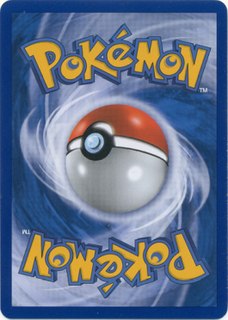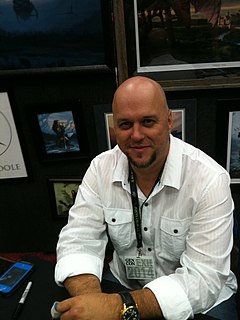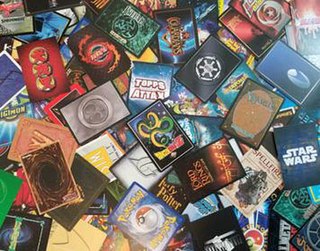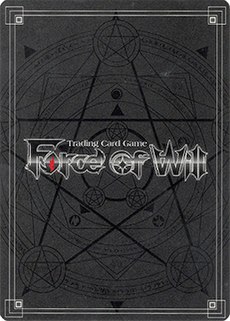
Magic: The Gathering is both a collectible and digital collectible card game created by Richard Garfield. Released in 1993 by Wizards of the Coast, Magic was the first trading card game and has approximately twenty million players as of 2015, and over twenty billion Magic cards produced in the period from 2008 to 2016 alone.
Netrunner is an out-of-print collectible card game (CCG) designed by Richard Garfield, the creator of Magic: The Gathering. It was published by Wizards of the Coast and introduced in April 1996. The game took place in the setting for the Cyberpunk 2020 role-playing game, but it also drew from the broader cyberpunk genre. Netrunner was lauded by critics, such as InQuest magazine, for its balanced game play and impressive artwork. In 1999 Pyramid magazine named Netrunner as one of "The Millennium's Most Underrated Games". According to editor Scott Haring, "among the connoisseurs of the card game design art, Netrunner is considered to be one of the best-designed games ever."
A trading card is a small card, usually made out of paperboard or thick paper, which usually contains an image of a certain person, place or thing and a short description of the picture, along with other text. There is a wide variation of different types of cards. Modern cards even go as far as to include swatches of game worn memorabilia, autographs, and even DNA hair samples of their subjects.
Star Wars: The Trading Card Game is an out-of-print collectible card game produced by Wizards of the Coast (WotC). The original game was created by game designer Richard Garfield, the creator of the first modern trading card game, Magic: The Gathering. After its initial release in April 2002, the game was 'put on indefinite hold' by WotC in late 2005. The Star Wars Trading Card Game Independent Development Committee was created by a group of fans to continue development of the game. They design new cards that are available as free downloads at their website.

The Pokémon Trading Card Game, abbreviated to PTCG or Pokémon TCG, is a collectible card game, based on Nintendo's Pokémon franchise of video games and anime, first published in October 1996 by Media Factory in Japan. In the US, it was initially published by Wizards of the Coast; The Pokémon Company eventually took over publishing the card game in June 2003. In 2016, it was the year's top-selling toy in the strategic card game subclass. In 2017, it had an 82% share of Europe's strategic card game market. As of March 2018, the game has sold over 25.7 billion cards worldwide.
For the 2011 indie game, see Sanctum.
Call of Cthulhu: The Card Game is an out-of-print card game produced and marketed by Fantasy Flight Games. It is based on Chaosium's Call of Cthulhu role-playing game, the writings of H. P. Lovecraft, and other Cthulhu Mythos fiction. In 2008, Fantasy Flight moved the game over to its Living Card Game (LCG) format, which retains the deck-building aspect of collectible card games, but without the random distribution.
John Avon is a fantasy and science fiction illustrator. Avon has published a book of his work and his work has been used for book covers, CD covers, games, toys and advertising campaigns. He is best known for his artworks for the collectible card game, Magic: The Gathering, of which he has produced over 200 paintings.

Guardians is an out-of-print collectible card game created by Keith Parkinson and Luke Peterschmidt, published by Friedlander Publishing Group (FPG) in 1995. In it, two players build armies led by powerful leaders called Guardians. Unlike many CCGs, there is a 4x3 "map" where armies maneuver; each player has strongholds on their "row", and the middle two rows are disputed. There are three potential victory conditions: a player can either defeat the enemy Guardian, conquer all 6 "disputed territories" in the middle two rows, or exhaust their opponent by depleting their armies ("shields").
Dixie is an out-of-print collectible card game that uses dice and special trading cards to allow players to refight famous American Civil War battles, such as the battles of First Bull Run, Shiloh, and Gettysburg. It was produced in 1994 by Columbia Games with rules loosely based on its 'wooden block' series of games.

Mark Poole is an American fantasy artist, best known for working on the first set of Magic: the Gathering cards.

Fred Fields is an American artist whose work has appeared largely in the Dungeons & Dragons fantasy role-playing game from TSR.

A collectible card game (CCG), also called a trading card game (TCG) or many other names, is a kind of strategy card game that was created in 1993 and consists of specially designed sets of playing cards. These cards use proprietary artwork or images to embellish the card. CCGs may depict anything from fantasy or science fiction genres, horror themes, cartoons, or even sports. Game text is also on the card and is used to interact with the other cards in a strategic fashion. Games are commonly played between two players, though multiplayer formats are also common. Players may also use dice, counters, card sleeves, or play mats to complement their gameplay.

Shadowverse is a free-to-play digital collectible card video game developed and published by Cygames in Japan. It was released for iOS and Android devices in June 2016, and by July was the most popular mobile collectible card game in Japan. Mac and Windows versions were released in October 2016. It began its overseas promotions since 2017, and there are three major versions by regions - Japanese, International, and Simplified Chinese.

Force of Will is a trading card game by Force of Will Co., Ltd. It was first released in Japan in December 2012 and later released to English speaking countries in 2013. The game is similar to Magic: the Gathering. The game has a tournament circuit.

A digital collectible card game (DCCG) is a computer or video game usually played online that emulates collectible card games (CCG), or in many cases, doesn't use card-like images at all, but instead icons, avatars or other symbols to represent game pieces. Originally, DCCGs started out as replications of a CCG's physical counterpart, but many DCCGs have foregone a physical version and exclusively release as a video game, such as with Hearthstone.
Flights of Fantasy is a fantasy trading card art set that was turned into a collectible card game near the end of its development and marketed as a "Collectors Card Set & Game". It was published by Destini Productions and was released in September 1994. The set had 118 cards and was sold only in booster packs. Scrye noted that the gameplay element was a "very minor" part to what was essentially a "card art set" and appeared to be "grafted on" and was about to fun to play as "doing your taxes". It was also noted that the game is generally not considered the second CCG released after Magic: the Gathering because of its gimmicky nature. All of the card art was created by Ed Beard Jr..
Singles are individual trading or game cards sold by hobby stores, online stores, or by individual collectors. These individual cards are usually of higher value than contemporary cards which are often sold as "bulk" or as a personal collection. Ordinary collectible cards serve little function beyond memorabilia, but CCGs are also used in game tournaments. Generally, collectible card games (CCG) fetch initial higher prices than trading cards because of the dual nature of being both a game and a collectable. Prices will fluctuate for CCGs as cards become legal or illegal to play in certain game formats.
Magic: the Gathering finance or MtG finance is the financial management and investment as it pertains to the collectibility and playability of the Magic: the Gathering collectible card game. Investments are typically made in single cards whose value are expected to rise over time such as from a shifting metagame or low quantities of cards that may or may not increase in value due to a growing playerbase and their demand. Like the stock market, cards are generally bought at a low price and/or are sold at a higher price during peak demand at a later date. Speculation is common as investors seek to predict which of the 18,970 unique cards will avoid a reprint thereby creating more demand. Speculation also occurs in the selling of card assets when a reprint is expected in an effort to maximize financial gain and minimize loss. Most financing is done through the buying and selling of cards, though some investors have traded their way to cards of higher value, or expected to gain value in the future. Additionally, some speculators have gone as far as manipulating the market by buying up large quantities of a single card in order to artificially inflate a card's price.











